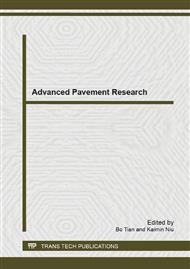p.222
p.227
p.232
p.239
p.248
p.259
p.266
p.271
p.277
Research of Built-In Temperature and Zero Stress Temperature of Cement Concrete Pavement at Early Ages
Abstract:
Based on field tests and numerical simulation methods, distribution characteristics of early-age built-in temperature of cement concrete pavement constructed in different seasons and pouring time were analyzed firstly. Then considering effect of creep, characteristics of early-age zero stress temperature in cement concrete that built-in temperature of cement concrete pavement constructed in different seasons and pouring time has a great difference. The distributions of built-in temperature along the thickness present nonlinear obviously, and they have four typical types: concave and positive gradient type, concave negative gradient type, convex positive gradient type and convex negative gradient type. Zero stress temperature gradient shows prominently developing process compared with built-in temperature of slab at different ages by the effect of creep. Zero stress temperature of slab poured on am7:00 in summer firstly increase and then decline. Besides, the positive gradient change to negative gradient gradually, and the gradient of zero stress temperature trend to decrease. At last, it is recommended to calculate zero stress temperature of slab consideration of base temperature and the nonlinear distributions characteristics, and the combined effect of creep and age.
Info:
Periodical:
Pages:
248-255
Citation:
Online since:
December 2013
Authors:
Price:
Сopyright:
© 2014 Trans Tech Publications Ltd. All Rights Reserved
Share:
Citation:


